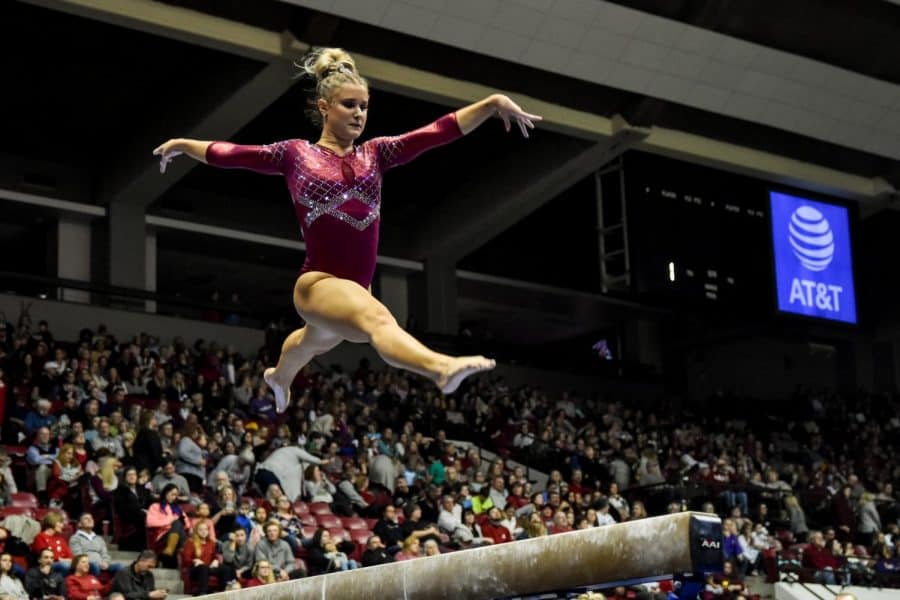Desch returns to freshman year floor routine
January 31, 2019
More than 13,000 fans packed into Coleman Coliseum last Friday to watch Alabama gymnastics host LSU – the largest gymnastics crowd at any school so far this season.
Though the Crimson Tide was trailing in the meet and would eventually lose, the fans had the same energy as ever, especially during junior Maddie Desch’s floor routine.
Desch has competed in the floor exercise in nearly every meet of her career, but as any of the team’s coaches or gymnasts will attest, there’s always room for improvement.
“[We were trying to have] a little more crowd involvement, a little more of her bright eyes being exposed to the judge [and] a little more clapping,” coach Dana Duckworth said. “If you listen to the replay, the crowd was clapping. That’s what I was going after, and we got it.”
Desch scored a 9.85, tying her season high on the floor after starting the season with scores of 9.75 and 9.8, none of which are poor scores given that she hasn’t used this routine in competition in two years.
Early this season, Desch decided to return to her freshman floor routine, a rarity because gymnasts typically change routines permanently about every two years.
“When I’m confident in a performance and comfortable with it, I tend to do better and show it off more,” Desch said. “And gymnastics is a sport where presentation is key. The routine I had before was really fun. I just didn’t have the comfort with it that I did with the routine that I’m doing now.”
Entering last week against LSU, Duckworth, one of the sport’s most respected choreographers, still thought Desch could enhance her stage presence. The coach made some tweaks to the routine itself as well.
“It was actually a big structure change, along with presentation and looking up and smiling and clapping with the crowd,” Desch said. “Every day we had practice, I would go over it and over it again and again so I could hear which beat went with the new move.
“When I’m not so worried about ‘am I going to be on the beat, am I doing this right, does it look good’ … I can use that new dance to draw the crowd in and genuinely have fun with it.”
Not only does that make the routine more fun for the gymnast and the crowd, it can also influence the judges’ scores, as the floor exercise is often the most subjective event to evaluate.
“If a judge says overall, ‘that floor routine had flat feet,’ they can take a half-tenth or a tenth if that’s just what is important to them,” Duckworth said. “It’s really within their right of the subjectivity, and that’s what gets difficult.”
Duckworth used senior Abby Armbrecht’s routine from Friday to explain the scoring. All competitors start with a baseline starting score of 9.5, which can be raised by performing certain skills, each assigned a rating from A to E, during the routine. Armbrecht’s routine begins with a double pike, a D skill worth a one-tenth bonus to the start value.
She also has a one-and-a-half-front layout, a combination of a C and a B skill that nets her two more tenths of a point. Another combination, a switch side popa, combines two C skills for another tenth, and a Rudi with a jump (a D skill with an A added on) puts her start value at 10.0. From that point, the judges deduct points based on mistakes they detect in the routine.
Armbrecht earned a 9.925 against LSU – a 9.95 from one judge and a 9.90 from the other. Duckworth predictably agreed with the more generous judge.
“I would’ve taken a half-tenth on her jump out of her Rudi,” Duckworth said. “I’m in the court with the judge that gave her a 9.95, because I couldn’t find another half-tenth.”
With 17 gymnasts on the team, Duckworth and the assistant coaches are constantly overseeing their routines and suggesting adjustments based on the gymnasts’ performance in competition and the toll the routines take on their bodies.
Junior Wynter Childers, unlike most of her teammates who can be hyper-technical at the expense of stage presence, said her struggle is to keep her technique sound while trying to put on a show.
“I’ve always had a problem with form,” Childers said. “Where a lot of girls that came in here are all technique and basics, I was always taught, ‘You can try it, just chuck it.’
“Especially on floor, I think I mostly focus on… interacting with the crowd and the judges. If the judges aren’t looking at me, I feel like something’s wrong. I’m just like, ‘Why aren’t you smiling at me? I’m trying to entertain you.’”
It might seem that maintaining the same happy-go-lucky energy on the floor would be easier in front of an admiring Coleman Coliseum crowd. But as the gymnasts prepare for back-to-back road meets at No. 16 Missouri this Friday and at No. 2 Florida, just having their teammates nearby is enough to fire them up.
“When you’re surrounded by your team and having them on the sidelines, a lot of times that does it for you,” Desch said. “For one part of my routine, I actually do it facing my team. I think having them there will give me the energy I need. And just the pure desire to want to do well for the team, I think that will create energy for myself.”





















